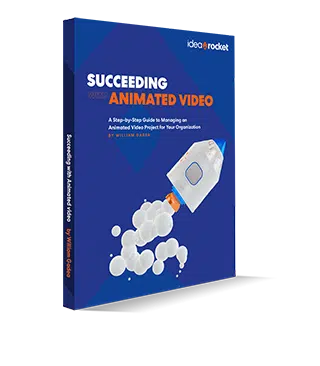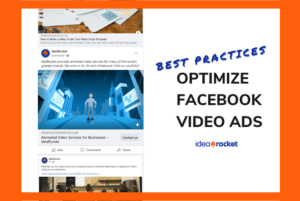The phrase “video narrative” can be intimidating. The idea of putting together the perfect script can be anxiety-inducing (where do you even begin?!) But when it comes to corporate video, creating the perfect narrative doesn’t mean producing a full-length mega-drama. In fact — the recipe for a successful video project is much, much simpler.
Making a great video with a compelling story doesn’t have to be complicated. It doesn’t matter what your video is trying to market; or if you use animated video, whiteboard, motion graphics, or live-action, the audience is always the same — your prospects and customers. To help you demystify video production, we’re going to outline the Four Elements of a Great Video Narrative and show you how you can include a few into just about any corporate or explainer video.
Back To The Basics: The Foundations Of A Great Video Narrative
According to Nigel Watts, author of Writing A Novel and Getting Published, classic storytelling is defined by eight essential points of narrative:
- Stasis
- Trigger
- The quest
- Surprise
- Critical choice
- Climax
- Reversal
- Resolution
All eight of these narrative points are great for your next novel, but videos and content marketing only have seconds to hook viewers and tell your story. An animated explainer video just doesn’t have the time to meander. So, I’ve boiled the eight elements of a great narrative down to four essential video narrative staples:
- Characters
- Quest
- Climax
- Resolution
Now that we’ve boiled it down to the basics, let’s dive into what each of these mean for your video.
Part One: Who is your hero?
Every tale has a hero, whether it’s an Oscar-worthy short, or a product explainer video. The hero in most animated explainer videos is the product or consumer, and they should be easy to identify.
Carefully create your hero early on, because your hero will define your audience and the problems they face. Focus on making characters that are relatable and engaging, and try to make it as easy as possible for your audience to connect by adding obvious character traits they can relate to (your buyer persona research will come in handy here!)
Animation allows for more flexibility to create characters that appeal to wider audiences, or bring what otherwise would be inanimate object to life. Different styles of animation, like 2D, stop motion, or whiteboard animation, can also evoke brand recognition, and connect your video to your larger brand story for a fuller experience.
Related: Expert Tips For Infusing Brand Into Your Video
Part Two: Conflict: Defining the pain point
Focusing on the conflict is one of the most effective ways to reach your target market with a video. When you build the video narrative around the pain points your customers face, you create an incentive for them to watch closely (aka they don’t want “x” to happen to them).
What is conflict in a video narrative?
The conflict in a traditional video narrative is the introduction of an obstacle to your audience’s happiness, productivity or effectiveness. Conflict can be a great opportunity for you to insert yourself into a potential customer’s decision-making process.
According to SiriusDecisions’ Buying Interactions Model, “The highest level of buyer/seller interaction for all buying scenarios occurs during the education phase of the buyer’s journey.” If you provide a solution during this process, you’re well positioned for conversions.

Introducing conflict into your video narrative
Remember that time is of the essence. Whatever your conflict, define it early and accurately. However, keep in mind that you don’t want to beat viewers over the head and be too obvious either. Define the situation then move onto how you can fix it. The conflict is the hook in your sales pitch—don’t forget to reel them in.
Take this video from Scandis, a direct-to-consumer furniture company, for example. In this animated explainer video, Scandis introduces the problem within the first ten seconds of the video by asking viewers “What does your furniture-buying dollar pay for?”
This question clearly defines expectations for what the audience should expect from the rest of the video. The problem Scandis chose here is also very buyer-stage focused. It challenges audiences to consider where exactly the money they’re spending is going — something you may not always think about when considering what couch is a good fit for your living room.
Part 3: Quest – Setting expectations
So you’ve done a great job introducing the conflict, but the real reason people watch your video is for the quest, or how your hero overcomes the problem at hand. This is where you get to make your product or service shine. Go all out on the quest — it’s the most fun part of the whole video narrative process, and if you do it right, people will remember, share, and talk about you.
Users need your product, and they need to know why they need it. Explain the problem (pain point) and the path to solving it in a compelling, logical way. This is the meat of the video narrative, and needs to be executed well to reach the final stage.
Let’s go back to the Scandis example. In the beginning of the video, they dare consumers to question whether or not they’re getting the most out of their money when investing in furniture. Scandis then goes on to explain common problems with traditional business models, how their business model is different from other companies, and how consumers can benefit (and ultimately save) from shopping with their brand. It’s game, set, and match when it comes to a compelling video narrative. Which brings us to the final piece of the puzzle:
Part Four: Resolution (and your CTA)
You’ve introduced the video’s hero, they’ve faced the conflict, endured the quest, and have arrived at the resolution. But what action to do want your consumer to take after they’ve seen your video? Depending on your objective, the resolution can be a continuation of the conversation, or merely awareness of the problem. It all depends on your path to conversion and your CTA.
Related: Your Ultimate Explainer Video CTA Guide
Animated videos are exceptionally effective narrative devices because they use simple visual cues to involve the audience in the story. Take your video to a happy conclusion that solves everything because that’s what a story is –a journey. A hero faces a problem, sets out to solve it, and comes home a victor. It’s a tale as old as time — you just have to fill in the spaces with your message. Construct a compelling narrative and your audience will be more receptive to your story and your product.
We’re here to make sure you look like a hero. Let us tell your story with an animated explainer video.




